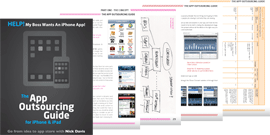There are also a few other advantages of iPhone and iPads that you may want your app to take advantage of.
Firstly, you should be clear about how your app is going to work in different orientations (portrait or landscape) or if it is only going to work in one. Generally most apps support different orientations and are happy to take advantage of this feature.
However some – game apps for example – may only support a single orientation for a good reason such as the way the game engine works. When this is the case Apple recommends that the app loads – and only operates in – that orientation.This way it will be obvious to users to rotate their device as soon as the app starts to load (Angry
Birds only displays in landscape mode for example).
Many app creators though will want to use this feature in some other way. In a news or information app for example, it might just be a simple adjustment like moving navigation elements or allowing more room for text when switching from portrait to landscape mode. For other apps though, its inclusion may be more innovative and it may be used to improve the functionality in some way. Whatever you do though it should be of some benefit to the user and not an annoyance.
Depending on the app you may also want to give users the ability to ‘lock’ it in a particular orientation or disable one of the views (perhaps as an option in the settings part of the app). If the user is likely to be moving around while using the app, or reading on their side while laying on a sofa or in bed for example, this might be an option.
Related to orientation is ‘tilt’.You will certainly have seen apps where tilting the screen has some impact on the functionality. Perhaps the most obvious example of this is a pinball game, but the functionality is seen across most apps (another common use is shaking the iPhone to refresh a page on an app). As ever, avoid the gimmick (unless the gimmick is the whole concept of the app) and think about how such movement might bring extra benefits to your users experience.
Finally there is GPS functionality, ie. the possibililty for your app to use your user’s location to influence what they are seeing on screen. For some the use of GPS is obvious (Time Out apps showing recommended restaurants near to a user’s current location) or even essential (TomTom sat navigation apps).Whatever your app though, think about how GPS might make your concept even better.
However you decide to use these elements, you need to make your developer aware of your decisions (either as part of your main brief or be specifying exactly what should happen in the Functionality List you created) so that these considerations are worked in from the start and also not decided for you.
